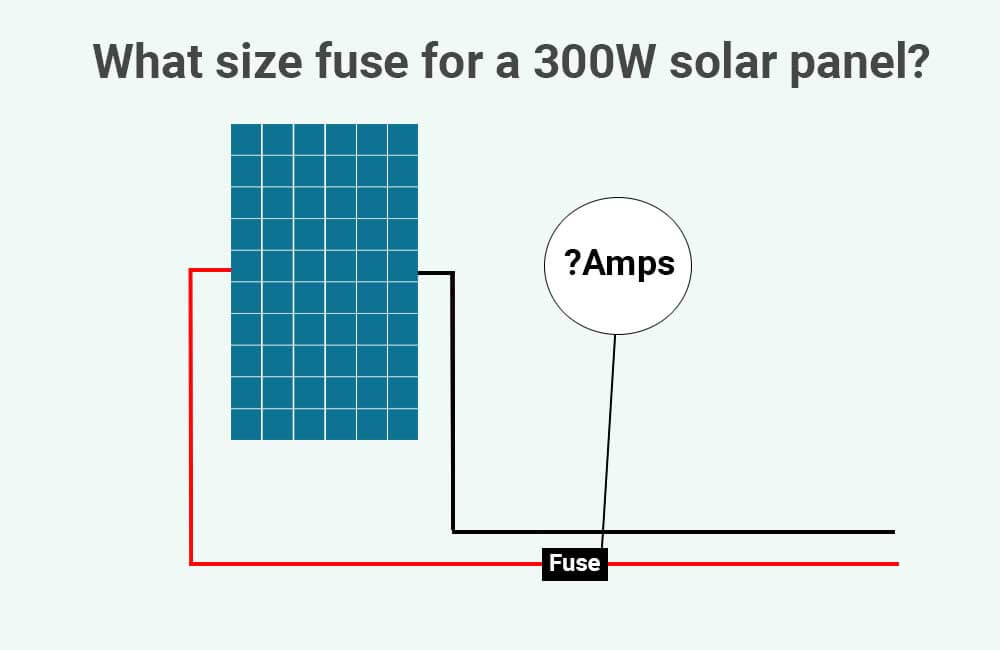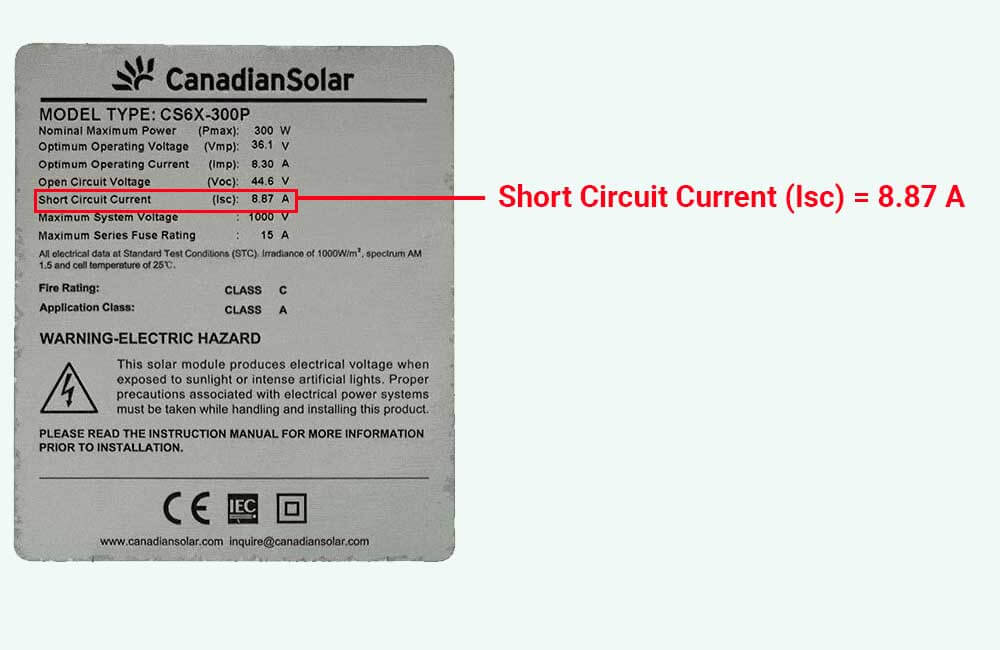Fuses and circuit breakers are what you call overcurrent protection devices (or OCPDs for short), and their job is to disconnect the circuit in case the current (in Amps) exceeds a certain threshold. This allows them to protect the wires and the equipment if – for any reason – an overcurrent occurs.
Fuses are rated in Amps, and the Amp rating on a fuse represents the amount of current at which the fuse breaks the circuit. For example, the strip of wire inside a 50 Amp fuse will break and disconnect the circuit if the current flowing through the fuse exceeds 50 Amps.
So, when sizing a fuse for your 300W solar panel, or in other words when trying to determine the Amp rating of the fuse that you need, the first thing to take into consideration should be the amount of current (in Amps) that your 300 Watt solar panel produces.
The Amp rating of the fuse should be high enough to allow the maximum amount of current that your 300W solar panel is capable of producing to flow through the circuit, but also low enough so that the fuse breaks the circuit when the amount of current is too high.
You can easily calculate the Amp rating of the fuse that you need for a solar panel using the Short Circuit Current rating on the solar panel.
Below, I’ll explain what a Short Circuit Current is, how to determine it, and how to use it to calculate the size of the fuse that you need for your 300W solar panel.

How many amps does a 300 Watt solar panel produce?
Solar panels have 2 kinds of current ratings (in Amps):
- The current at which the solar panel produces its rated power (300 Watts in our case). This current rating is generally referred to as Maximum Power Current or Optimal Operating Current, “Imp/Impp” for short.
- And the current that the solar panel produces when it’s short-circuited. This current is generally referred to as Short Circuit Current, “Isc” for short.
Generally, if the 300 Watt solar panel is rated at 12 Volts (nominal), its Optimal Operating Current (Imp) will be between 13 and 19 Amps, but depending on the solar panel, its Short Circuit Current (Isc) could be as high as 22 Amps.
If the 300 Watt solar panel is rated at 24 Volts, its Optimal Operating Current (Imp) will be between 7 and 10 amps, and its Short Circuit Current (Isc) could be as high as 11 Amps.
It is worth noting that the actual amount of current that a 300 Watt solar panel produces is not constant and will fluctuate during the day depending on how much sunlight the solar panel receives, and which type of charge controller is used.
Related: What size charge controller for 300W solar panel?
However, what really matters when sizing a fuse or a circuit breaker for a solar panel, is the Short Circuit Current rating of the panel. So, before you can determine the size of the fuse, the first step is to determine the Short Circuit Current rating of your solar panel.
This Short Circuit Current rating is generally found on the specification label stuck to the back of your solar panel, or on the specification sheet provided by the manufacturer.
For example, here’s an image of the specification label stuck on the back of a 24V-300W solar panel from Canadian Solar:

In the image above, you can see that the manufacturer specifies a Short Circuit Current of 8.87 Amps for this 24V-300W solar panel.
If your 300W solar system is made out of multiple solar panels, the Short Circuit Current of the system will depend on:
- The Short Circuit Current of each solar panel.
- And whether the solar panels are wired in Series or in Parallel.
Series connection:
For example, let’s say you have 2 12V-150W solar panels in series to make up a 24V-300W solar string. And let’s say that these solar panels are identical, and each has a Short Circuit Current rating of 9 amps.
As I explain in my article about the difference between series and parallel connections, when identical solar panels are wired in series, the total Short Circuit Current of the solar string is equal to that of a single solar panel.
Since we have 2 identical solar panels in series in our example, and each has an Isc of 9 Amps, the total Isc of our solar string is also 9 Amps.
Parallel connection:
Now, let’s say we use the same 2 12V-150W solar panels, but this time, we wire them in parallel to make up a 12V-300W solar array.
When solar panels are wired in parallel, the total Short Circuit Current of the solar array is equal to the sum of the Short Circuit Current of all the solar panels in the array.
Since we have 2 solar panels in parallel, and each solar panel has an Isc of 9 Amps, the total Isc of our system is:
Total Short Circuit Current (Amps) = Short Circuit Current 1 + Short Circuit Current 2
Total Short Circuit Current (Amps) = 9 Amps + 9 Amps
Total Short Circuit Current (Amps) = 18 Amps
So, in this particular case, the size of the fuse between the solar array and the solar charge controller should be calculated using this Short Circuit Current value (18 Amps).
However, it is very important to note that in parallel connections, in addition to the fuse between the point where the solar panels are combined and the solar charge controller, a fuse for each parallel string will be needed.
This is to ensure that short-circuited solar panels are immediately disconnected, therefore preventing any current coming from the other solar panels to go through the shorted solar panel, which could potentially damage it.
In other words, our 12V-300W solar array would require 3 fuses:
- 1 fuse between the solar array and the solar charge controller, which size is calculated using 18 Amps (total Short Circuit Current of the array)
- And 2 fuses for each solar panel, which sizes are calculated using 9 Amps (Short Circuit Current of each solar panel)
If your 300W solar system consists of multiple solar panels in parallel, I recommend reading the following article: What size fuse between solar panel and charge controller?
Now, let’s discuss how you can use the Short Circuit Current of your solar panel to calculate the required Amp rating of the fuse.
What size fuse for 300W solar panel?
In general, if the 300W solar panel is rated at 12 Volts nominal, the fuse should be rated at 30 or 35 Amps depending on the solar panel. If the 300W solar panel has a nominal voltage of 24 Volts, the fuse should be rated at 15 or 20 Amps.
As mentioned above, the exact Amp rating of the fuse that you need should be calculated using the Short Circuit Current rating of the solar panel. This can be done using the following formula:
Fuse Size (in Amps) = Short Circuit Currant (Amps) x 1.56
Learn more about this formula here.
For example, let’s say you have a 24V-300W solar panel that has a Short Circuit Current rating of 10 Amps. The required fuse size is calculated as such:
Fuse Size (in Amps) = Short Circuit Currant (Amps) x 1.56
Fuse Size (in Amps) = 10 Amps x 1.56
Fuse Size (in Amps) = 15.6 Amps
Now, there are no fuses rated exactly at 15.6 Amps. However, all we have to do is find the next higher standard fuse size.
Standard Fuse Amp ratings are: 10, 15, 20, 25, 30, 35, 40, 45, 50, 60, 70, 80, 90, 100, 110, 125, 150, 175, 200, 225, 250, 300, 350, 400, 450, 500, 600, 700, 800, 1000, 1200, 1600, 2000, 2500, 3000, 4000 5000, and 6000 Amps.
In our case, the next standard fuse size is 20 Amps, and that is the Amp rating of the fuse that we need for our solar panel.
To give another example, let’s say we’re trying to size a fuse for a 12V-300W, that has an Isc of 21.5 Amps:
Fuse Size (in Amps) = Short Circuit Currant (Amps) x 1.56
Fuse Size (in Amps) = 21.5 Amps x 1.56
Fuse Size (in Amps) = 33.54 Amps
The next larger stand fuse size, in this case, is 35 Amps.
An important thing to add is that after calculating the Amp rating of the fuse that you need for your 300W solar panel, you’ll have to make sure that this amp rating does not exceed the Ampacity of the wire you’re using.
If the amp rating of the fuse is higher than the ampacity of the wire, the fuse will not be able to do its job, which is to break the circuit in case the current exceeds what the wires can safely carry.
If the wires you use for your 300W solar panel are sized properly, this shouldn’t be an issue. If you haven’t yet sized the wire that you need for your 300W solar panel, please refer to the following page: What size cable for a 300W solar panel?


